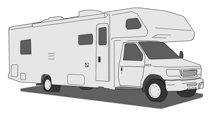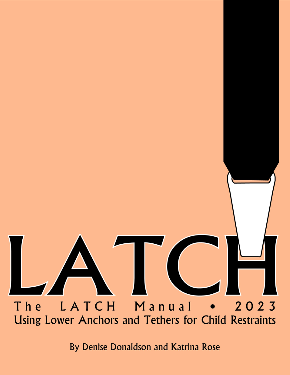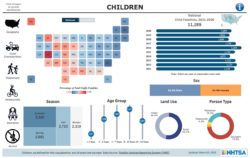In recent years, recalls directly related to CPS have been more common among vehicles than CRs. And, since all recalls are safety-related, any vehicle recall (including the vastly greater number that are not specifically about CPS) can indirectly harm child passengers. So, the fact that NHTSA says over 50 million vehicles on the road have one or more open recalls is a serious safety concern.
Read More from “Checking for Recalls? Don’t Forget the Vehicle”News
Editorial: RV Travel Savings Unlikely to Pencil Out When Safety Is Added to the Equation
CPSTs should be prepared for a potential rise in RV interest among families. In a study published earlier this year, researchers compared the cost of visiting nine popular U.S. tourist destinations over three vacation durations. For every scenario, the researchers concluded that traveling by RV was significantly less expensive than trips involving other modes of transportation (planes, cars) or lodging (hotels, rental properties).
Read More from “Editorial: RV Travel Savings Unlikely to Pencil Out When Safety Is Added to the Equation”2023-2024 LATCH Manual Update
Ask Katrina: Sometimes, Finding Information for Using CRs in Pickup Trucks Is Half the Battle
In this regular column, SRN shares vehicle-related information from Katrina Rose, SRN collaborator and vehicle liaison for the LATCH Manual. For the March/April 2023 issue, Katrina shared answers to some questions posed by technicians regarding pickup trucks.
Because pickup trucks are very popular while at the same time often challenging for CR use, SRN focuses special attention on understanding them so we can provide helpful guidance in our publications, such as the LATCH Manual.
Read More from “Ask Katrina: Sometimes, Finding Information for Using CRs in Pickup Trucks Is Half the Battle”When and How to Break a Car Window
In an emergency, know these right (and wrong) ways to purposely shatter automotive glass
Most CPSTs have noticed that TV shows rarely depict CPS best practices. An episode from ABC’s Modern Family provides a good example when a dad frantically runs toward his vehicle intending to break a window with a garbage can to free his infant daughter locked inside.
Read More from “When and How to Break a Car Window”“Ask Katrina” Column
Regular column will highlight vehicle-specific tips from SRN’s vehicle specialist
In a new column, “Ask Katrina,” SRN will share vehicle-related CPS information from Katrina Rose, SRN collaborator and vehicle liaison for the LATCH Manual. Katrina regularly fields questions posed by technicians in the field, so this column will provide an opportunity to share her answers and insights with all SRN readers.
We’ll kick off the column with a fundamental question:
Read More from ““Ask Katrina” Column”New Resources Worth a Closer Look
SRN readers are likely to be savvy users of the most fundamental resources for CPSTs—all the more reason to read this article carefully for important updates.
Readers may have noticed a couple of new resources mentioned a lot lately: Child Passenger Safety Learning Portal and the National CPS Board YouTube page. Both have popped up quite a bit in recent social media posts and articles directed at CPSTs, and some readers may have already bookmarked these links. But these particular resources warrant a closer look, as they are not simply handy new websites to keep in our back pocket (though they are indeed handy). In fact, they represent important revisions to how key CPS information is offered—and will be offered going forward. As such, all CPSTs should be aware of these resources and incorporate them into their CPS practice.
Read More from “New Resources Worth a Closer Look”“Help! Riding Rear Facing Makes My Child Sick!”
CPSTs are occasionally approached by caregivers whose children struggle with car sickness, and those with younger children sometimes wonder if riding rear facing is the crux of this problem. In Washington state (where the law requires children to ride rear facing until age 2), state CPS coordinator Cesi Velez was asked a question on this theme. The caregiver of a 19-month-old wanted to know if a doctor could issue her a letter of exemption from the state’s child occupant protection (COP) law. Her child had been vomiting in her car seat, and the parent felt that having the child face forward would solve the problem.
Read More from ““Help! Riding Rear Facing Makes My Child Sick!””Data to Drive the CPS Field
Nowadays, it’s a given that data drives professional decision-making. So, it’s essential for those working in the CPS field to be aware of and have access to reliable data sources. Important activities, including budgeting, program planning, fundraising, research, and advocacy, all benefit from using relevant data.
Read More from “Data to Drive the CPS Field”The Truth About “True” Lock-Offs
A few years ago, SRN reported on an emerging phenomenon: CRs with features that looked and acted like lock-offs but weren’t.
Since then, these features have become more common. Nowadays, CPSTs who see anything that looks like a lock-off ask, “Is that a true lock-off?” While a mechanism that functions as a lock-off must be a “true,” authentic lock-off, “true lock-off” has become part of the CPST vernacular when wondering whether a CR part that appears to be a lock-off actually is one.
Read More from “The Truth About “True” Lock-Offs”



